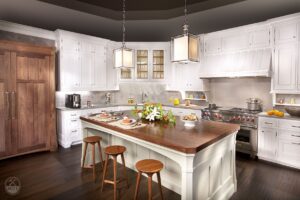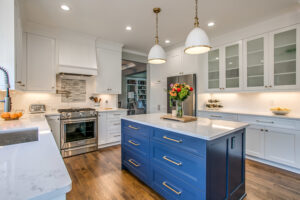The kitchen is a focal point in most homes and it’s where residents and guests gather for food and fellowship. When outfitting a kitchen with new cabinets or a full kitchen remodel, the first step is selecting the kitchen style that best fits your home, preferences and needs.
Learn about the three primary styles for kitchens to see which is the best fit for your home.
Contemporary/Modern Kitchen Style

Contemporary or modern kitchens feature sleek, clutter-free spaces. The style is clean and brings together a modern, minimalist design, generally with some wood accents and flat-front cabinets.
This kitchen style is in high demand because it is in line with current trends. You’ll find eco-friendly materials, plenty of techs, and storage that aids in the minimalist appearance. The great part about kitchens in this style is that they are great for everyday life or entertaining.
The style started in the 1970s but has evolved to meet modern demands. It works best in homes where the kitchen opens to other rooms in the home, such as the living room or dining area. Plus, homes with large windows that bring natural light into the kitchen tend to resonate well with a contemporary kitchen.
You’ll see the less-is-more approach throughout a modern kitchen. No element is there to just fill space. It has a clear and useful purpose.
When selecting cabinets for a contemporary kitchen, look for sleek, yet angular designs. You don’t want ornamentation on your cabinets though as the goal is to focus on function. Generally, the two styles of cabinets you’ll find in a contemporary kitchen are shaker and flat-front. These cabinets have simple lines.
Most shaker cabinets are made from oak, hickory, or maple. You might also see flat-front cabinets listed as slab doors because they have no framing and are made from one piece of painted wood or wood veneer.
Although the goal is minimalism, you can contrast your cabinet color to that of your countertop, floor, or backsplash to keep the kitchen looking interesting and attractive.
For the handles, many homeowners go with long brass because they fit a variety of color schemes. But if you want the handles to stand out a bit more, you might go with V-shaped pulls. Another option is to use flat or matte black hardware for a more dramatic effect.
Traditional Kitchen Style

A traditional kitchen is timeless. Generally, you’ll find simple designs with a few bold accents sprinkled throughout. These kitchens have incredible attention to detail that often includes embellishments. But the key is in ensuring that the embellishments never become overbearing.
Within a traditional kitchen, you might find crown molding or wainscoting. The traditional kitchen has many adornments, generally. You’ll be working with a traditional color palette that includes warm and cool neutrals. Popular options for traditional kitchens include walnut or various shades of warm whites.
Popular countertop options for traditional kitchens include granite or quartz. And you can feel free to select slabs that have some pattern or lines to them.
The cabinets within traditional-style kitchens often are embellished or the complete opposite of contemporary kitchen cabinets. Some options include flat panels or not as popular today, classic raised panels. These cabinets might feature paint instead of a glazed finish or natural wood look.
When choosing lighting, go decorative. A classic chandelier can be the focal point of a traditional kitchen and enhance the ornate appearance of it all. These statement pieces can pull the kitchen together and add incredible design to the space.
Transitional Kitchen Style

A transitional kitchen brings together the best elements of a contemporary and traditional look. It allows homeowners to blend the styles without the kitchen looking mismatched. You can have the best of both worlds with a cohesive style that feels warm and modern all at once.
The other great thing about a transitional kitchen is that it is like no other kitchen. It’s entirely unique to the homeowner but you will find some elements that are similar among all transitional kitchens.
When designing a transitional kitchen, you’ll be blending styles based on your preferences. This is where working with a skilled designer can help ensure you end up with a beautifully blended design.
If you’re unsure whether a transitional kitchen is right for you, consider how you want the space to feel. This style is often characterized as airy and casual. The design is ageless because it brings in traditional aspects but has some modern touches to bring it into the current decade.
When choosing your cabinets, know that a transitional kitchen never uses ornate cabinets or cabinets with heavily decorated molding or corbels. Instead, cabinets are simple but with more options than a modern kitchen allows for.
Cabinets in transitional kitchens are often made from wood with a streamlined profile and are not lacquered. You might select recessed or paneled-style doors to fit with the rest of your kitchen. For a kitchen that pulls a bit more into the modern style than traditional, go with shaker cabinets for an uncluttered appearance.
Neutral tones and white tend to be the best color palette for cabinets in transitional kitchens to build a light and airy feel. When selecting how many and where to put your cabinets, consider how you’ll keep small appliances and other items off your counters to keep the space free of clutter as the style calls for.
Add barrel pulls to your cabinets for a modern finish to traditional cabinets or silver rectangular handles if you’re using contemporary shaker cabinets. Many transitional kitchens employ black or brass accents to finalize the appearance.
Selecting the Best Cabinet Design
Ultimately, your kitchen is a reflection of your style and personality. For expert design advice and high-quality cabinetry, visit French’s Cabinet Gallery at 7108 Crossroads Boulevard, Suite 304, Brentwood, Tennessee, or call 615-371-8385.


